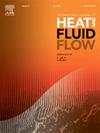Heat sink optimization with response surface methodology for single phase immersion cooling
IF 2.6
3区 工程技术
Q2 ENGINEERING, MECHANICAL
International Journal of Heat and Fluid Flow
Pub Date : 2025-01-27
DOI:10.1016/j.ijheatfluidflow.2025.109745
引用次数: 0
Abstract
One of the biggest challenges to technological advancements is the inability to efficiently dissipate waste heat from electronic components, which negatively effect performance and reliability. Immersion cooling systems provide an effective alternative for thermal management due to their high cooling capacity, uniform heat distribution and economic advantages. This study focuses on enhancing the thermal efficiency of single-phase immersion cooling systems by optimizing the geometric parameters of a heat sink, a passive cooling method. The innovation of this work lies in the systematic optimization of three key parameters: fin height, channel width and heat flux. These parameters were varied at three levels and an experimental design was developed using response surface methodology (RSM), which involved conducting 15 experiments. The optimal values for maximum thermal performance were determined to be 2.0 mm for channel width, 13.8889 mm for fin height and 45898.98 W/m2 for heat flux. The study reveals that the most influential parameters on thermal enhancement are channel width, fin height and heat flux respectively. The results demonstrate significant potential for improving thermal management in electronic cooling systems. Based on the findings, a reliable correlation for the enhancement rate is proposed, offering a practical tool for designing more efficient and sustainable cooling systems. This innovative approach contributes to the development of more effective thermal management solutions, with potential applications in industries such as electronics, power systems, and data centers.
求助全文
约1分钟内获得全文
求助全文
来源期刊

International Journal of Heat and Fluid Flow
工程技术-工程:机械
CiteScore
5.00
自引率
7.70%
发文量
131
审稿时长
33 days
期刊介绍:
The International Journal of Heat and Fluid Flow welcomes high-quality original contributions on experimental, computational, and physical aspects of convective heat transfer and fluid dynamics relevant to engineering or the environment, including multiphase and microscale flows.
Papers reporting the application of these disciplines to design and development, with emphasis on new technological fields, are also welcomed. Some of these new fields include microscale electronic and mechanical systems; medical and biological systems; and thermal and flow control in both the internal and external environment.
 求助内容:
求助内容: 应助结果提醒方式:
应助结果提醒方式:


